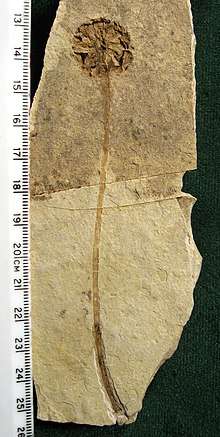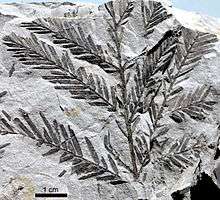Metasequoia occidentalis
Metasequoia occidentalis is an extinct redwood species of the family Cupressaceae that is found as fossils throughout the Northern Hemisphere. It is one of three extinct species of Metasequoia that are currently recognized as valid.[2][3]

| Metasequoia occidentalis | |
|---|---|
 | |
| Metasequoia occidentalis foliage; early Paleocene, Alberta, Canada | |
| Scientific classification | |
| Kingdom: | Plantae |
| Clade: | Tracheophytes |
| Division: | Pinophyta |
| Class: | Pinopsida |
| Order: | Pinales |
| Family: | Cupressaceae |
| Genus: | Metasequoia |
| Species: | †M. occidentalis |
| Binomial name | |
| †Metasequoia occidentalis | |
History
Fossilized Metasequoia-like remains were noted in Europe and North America as long ago as the 1800s but were assigned to a variety of other genera such as Sequoia (redwoods) and Taxodium (bald cypresses). Many remains are found in bunches near clumps of coal, almost preserving them. It was not until living Metasequoia trees (Metasequoia glyptostroboides) were discovered and described from a remote area of China during the 1940s, that true affinity of most of these fossils became apparent.[4][5]
The species M. occidentalis is based on fossils that were originally described as Taxodium occidentale by John Strong Newberry in 1863. In 1951 they were reassigned as M. occidentalis by Ralph Works Chaney based on their close resemblance to living Metasequoia.[1] It has been said that, with few exceptions, the bulk of the fossils described in the literature indicate that M. occidentalis was indistinguishable from living Metasequoia glyptostroboides.[6]
Description
Like living Metasequoia, M. occidentalis was deciduous. The foliage consists of branchlets with oppositely arranged leaves. The leaves are ovate to linear in shape, ranging from 6–25 mm in length and 1–2 mm in width, with a distinct midvein, a petiolate base, and an acute tip. The seed-bearing cones are globose to ovoid, 11–40 mm long and 6–34 mm wide, with decussately arranged triangular scales, and are borne on long, leafless stalks. The seeds have two wings, are ovoid to cordate in shape, and are up to 5 mm long and 4 mm wide. The pollen-bearing cones are small, globose to ovoid, 1–5 mm long and 0.5–4 mm wide, and oppositely arranged on specialized stalks with one terminal cone.[2][3]
Age and Distribution
Metasequoia occidentalis appeared in fossil record during the Late Cretaceous epoch (Cenomanian stage). By the Tertiary period it had become a major constituent of lowland and swampy forests in the northern circum-Pacific and polar regions, where it commonly coexisted with Glyptostrobus europaeus. Fossils assignable to M. occidentalis have been reported from parts of the United States, Canada, Russia, China, Japan, Greenland and Svalbard, but Metasequoia appears to have been rare or absent in much of Europe.[6]
References
| Wikimedia Commons has media related to Metasequoia occidentalis. |
- Chaney, R.W., 1951. A revision of fossil Sequoia and Taxodium in western North America based on the recent discovery of Metasequoia. Transactions of the American Philosophical Society, v. 40, pt. 3 (1950), p. 171-263.
- Stockey, R.A., Rothwell, G.W. and Falder, A.B. 2001. Diversity among taxodioid conifers: Metasequoia foxii sp. nov. from the Paleocene of central Alberta, Canada. International Journal of Plant Sciences, v. 162, p. 221-234.
- Liu, Y-J, Li, C-S, and Wang, Y-F, 1999. Studies on fossil Metasequoia from north-east China and their taxonomic implications. Botanical Journal of the Linnaean Society, v. 130, p. 267-297.
- Chaney, R.W., 1948. Redwoods around the Pacific basin. Pacific Discovery. v. 1, no. 5, p. 4-14.
- Fulling, E.H. 1976. Metasequoia – fossil and living. The Botanical Review, v. 42, p. 215-315.
- LePage, B. A., Yang, H., and Matsumoto, M. 2005. The evolution and biogeographic history of Metasequoia. In: The geobiology and ecology of Metasequoia, pp. 3-114. Springer, Netherlands.